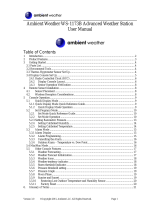Problem: Temperature, humidity, or air pressure is incorrect.
Solution:
1) Check/Replace batteries.
2) If multiple remote sensors are in use, check location with corre-
sponding “boxed numbers.”
3) Move away from sources of heat/cold.
4) Adjust relative air pressure to a value from a reliable source (TV
radio, etc.).
5) The indoor weather station and remote sensors are calibrated at
the factory. If there is a consistent problem, please call La Crosse
Technology.
Problem: “- -” in humidity display.
Solution:
1) Humidity is below 1% or above 99%.
2) TX3U or TX3UP is used for remote temperature.
Problem: WWVB time and date will not set or update
Solution:
1) Wait until overnight for signal to be received
2) Move indoor weather station away from sources of electricity
3) Place indoor weather station in window facing Colorado
4) The first reception is most difficult, as the indoor weather station
needs five continual minutes of clear signal reception. After the
initial time/date set, the indoor weather station only requires one
full minute of clear reception each night.
SPECIFICATIONS
Indoor weather station recommended
operating temperature 32˚F to 122˚F (0˚C to 50˚C)
LCD contrast 8 levels (0-7)
Temperature measuring range
Indoor 14.2˚F to 139.8˚F with 0.2˚F resolution
(-9.9˚C to 59.9˚C with 0.1˚C resolution)
(“OFL” displayed if outside this range)
Outdoor -21.8˚F to 157.8˚F with 0.2˚F resolution
(-29.9˚C to 69.9˚C with 0.1˚C resolution)
(“OFL” displayed if outside this range)
Relative humidity range
Indoor 1% to 99% with 1% resolution,
indoor weather station displays “—.-”
if outside this range
Air pressure
Relative hPa (adjustable) 960 hPa to 1040 hPa
Relative inHg (adjustable) 28.35 inHg to 30.72 inHg
Sensitivity setting hPa 2 hPa to 4 hPa
Air pressure history For the past 12 hours
(0, -3, -6, -9, and -12 hours)
Data checking intervals
Indoor temperature Every 15 second
Indoor humidity Every 20 seconds
Outdoor temperature Every 5 minutes
Transmitter reading update (within sensor)
Outdoor temperature Every 1 minute
Tr ansmission frequency 433.92 MHz
Tr ansmission range 330 feet (100m)
Power supply
Indoor weather station: 2 x AA, IEC LR6, 1.5V batteries.
Remote temperature sensor: 2 x AA, IEC LR6, 1.5V batteries.
Dimensions (H x W x D)
Indoor weather station 8.75" x 4" x 1.5"
(222 x 102 x 38 mm)
Remote temperature sensor 5.04" x 1.57" x 0.9"
(128 x 40 x 23 mm)
WARRANTY INFORMATION
La Crosse Technology, Ltd provides a 1-year limited warranty on this
product against manufacturing defects in materials and workmanship.
This limited warranty begins on the original date of purchase, is valid
only on products purchased and used in North America and only to
the original purchaser of this product. To receive warranty service, the
purchaser must contact La Crosse Technology, Ltd for problem deter-
mination and service procedures. Warranty service can only be per-
formed by a La Crosse Technology, Ltd authorized service center. The
original dated bill of sale must be presented upon request as proof of
purchase to La Crosse Technology, Ltd or La Crosse Technology, Ltd’s
authorized service center.
La Crosse Technology, Ltd will repair or replace this product, at our
option and at no charge as stipulated herein, with new or recondi-
tioned parts or products if found to be defective during the limited war-
ranty period specified above. All replaced parts and products become
the property of La Crosse Technology, Ltd and must be returned to La
Crosse Technology, Ltd. Replacement parts and products assume
the remaining original warranty, or ninety (90) days, whichever is longer.
La Crosse Technology, Ltd will pay all expenses for labor and materi-
GB
P.21
GB
P.22

























